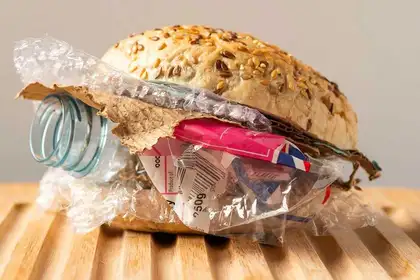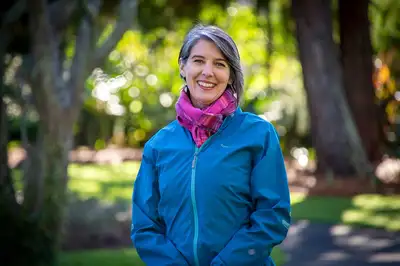
Image from the UNWRAPPED conference in the US this month, which examined the risks to health from plastic in our food.
We tend to trust plastic as a safe form of packaging and storage for food and drink. And we feel good about recycling our plastic waste. But consumers need to be aware of emerging research exposing how toxins from plastic and other single-use packaging are leaching into our food and drink, says Dr Trisia Farrelly.
Dr Farrelly, a Massey University environmental anthropologist who researches plastic pollution, recently attended an international conference in the United States on the latest findings on food and beverage contamination from plastic packaging.
The news from the conference Unwrapped: The health risks of plastics and food packaging chemicals sounds dire, revealing that chemicals in plastic food packaging can have harmful effects to our health. But Dr Farrelly says awareness of the risks and dangers of toxins entering the food system could spark positive change in the food industry and among consumers.
“I’ve been working in this field for some time and it was an honour to be invited to attend this 120-strong workshop of some of the top researchers in ecotoxicology, food packaging, as well as leaders of international advocacy groups to workshop an international strategy to regulate toxins in food packaging,” she says.
As knowledge about the risks of microplastics in food becomes more widespread, we will be adding new terms to our vocabulary of health threats. Many have heard of Biphenol A (BPA) and seek BPA-free food and drink containers. “Unfortunately, industry has found loop-holes by using alternatives in ‘BPA-free’ bottles by simply using other bisphenols (such as BPS) which are even more harmful than BPA,” says Dr Farrelly, who is based in the School of People, Environment and Planning.
Look out for PFAS (per- and poly-fluoroalkyl substances) – synthetic chemicals used in a wide range of industries and consumer products, she warns. Most people have been exposed to them – there are around 3000 types – and they do not break down and go away. “In other words, they are persistent organic pollutants (or POPs). What’s most disturbing is that PFAS are used as a moisture barrier in cardboard and paper used in food packaging, such as pizza boxes. They are also used in non-stick cookware,“ Dr Farrelly says.
Then there are NIAS (non-intentionally added substances), or toxicants introduced through recycling process. These include chemicals such as flame retardents, dyes and additives, and are “deeply concerning,” she says. “Every time you recycle plastic it degrades producing more and more NIAS.”
What makes NIAS and intentionally added toxicants in food harmful to human health? Research, she says, shows many can act as endocrine disrupting chemicals (EDCs) which are hazardous at extremely low doses. EDCs have been implicated in a wide range of disease including cancers, obesity, fertility problems, male impotence, heart disease, and precocious (early onset) puberty. Other additives found in printing ink, stabilizers, adhesives, flame retardants, and UV-blockers pose health hazards including neurotoxicity, cancers, and renal, reproductive and respiratory disease.

Environmental anthropologist Dr Trisia Farrelly, who attended UNWRAPPED to find out about the latest research on the health risks from plastic.
When recycling plastic is bad
So, just when we thought food packaging made from recycled plastics sounded like a great idea, and the answer to a huge waste management problem, it turns out to be the opposite.
What’s clear is the need for new industry guidelines, says Dr Farrelly – “never use recycled plastic for food packaging or storage unless you undertake a number of stringent steps – an improved sorting process, a super clean recycling process, creating functional barriers between your food and food packaging, and ban toxic chemicals used in food packaging.
“The global plastic pollution crisis is not just about the environmental impacts anymore, it’s not just about climate change anymore, it’s also about our health – and the health of the soil and the plants and animals we eat, the water we drink and the air we breathe.”
Her insights echo last week’s news headlines from an Australian report revealing that humans ingest the equivalent of a credit card-sized amount of micro-plastics each week, mostly through tap and bottled water. Dr Farrelly says that while we need to get rid of all plastic water bottles for environmental and health reasons, micro-plastics and their associated toxins are present in a myriad of food products too.
Hopeful solutions in glass, steel and organics
There are hopeful, practical solutions, she emphasises. These include longterm, structural changes in the food packaging, retail, and recycling industries. For example, supermarkets and food stores that offer refill options should be encouraged, she says.
“Multi-layer food packaging (like Tetrapak) should be banned, as should all expanded polystyrene, and all single-use food packaging should be phased out. Reuse and reduce should play a bigger role in New Zealand’s food delivery systems. Food packaging-to-volume ratio needs to decrease. We need to shift focus to local food production and develop and support safe, local recycling businesses.
“We also need eco-labelling. Consumers should be informed which tin cans have plastic (epoxy) linings and which don’t, particularly if you don’t want BPA in your tinned tomatoes or coconut milk. I want to know at a glance if an independent body considers my food packaging high, medium, or low risk so I can make an informed purchase.”
At an individual level, she suggests people choose glass and stainless steel over plastics. If you must use plastics for food storage, avoid, heating them or using them in microwave ovens or dishwashers. Don’t store acidic or fatty foods in them to avoid toxins from the plastics leaching into food and drink.
Dr Farrelly sees the opportunity for innovation and creative thinking in developing new non-toxic packaging made from locally-sourced materials. Ideally these would be sustainably-grown and toxicant-free or made of toxicant-free waste materials such starch from potato peelings or cellulose from forestry waste such as bark, hemp, or flax.
Greater awareness of the issue is the next step for New Zealand. “I don’t have all the answers but we need to exercise precaution now that we have more information, and we know industries need to rethink what they are delivering our food in, and the implications for the health of all New Zealanders,” she says.
Dr Farrelly is a member of the Political Ecology Research Centre at Massey, a member of the New Zealand Product Stewardship Council and is on a range of international research groups, including the taskforce advising the United Nations Environmental Assembly Expert Group on marine plastic pollution.
(UNWRAPPED is part of Plastic Exposed, an international project working to increase global recognition of the known human health risks of plastic and other single-use food packaging, while promoting a culture shift to non-toxic, re-useable alternatives).